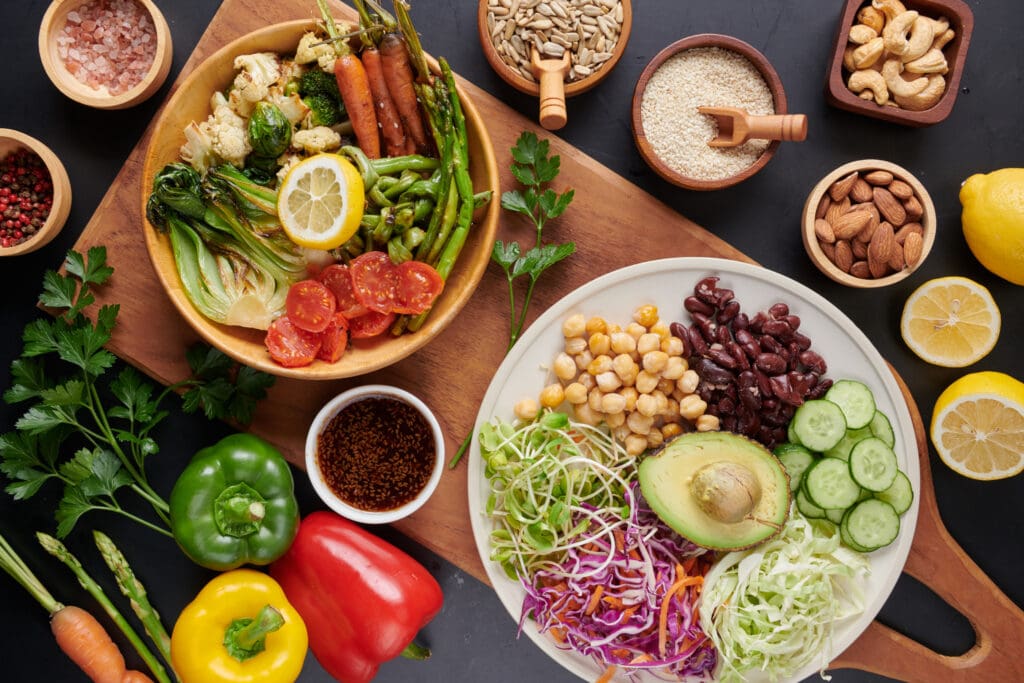
Foods to Eat During Your Luteal Phase
What you eat during the luteal phase can make a significant difference in how you feel. A nutrient-rich diet tailored to this phase can help stabilise hormones, reduce PMS symptoms, and prepare your body for menstruation. Let’s explore some of the best foods to support your luteal phase and practical tips to make them part of your routine.
Disclaimer: Every woman’s body is beautifully unique. These tips are general recommendations, but they may not suit everyone. We encourage you to tune in to your body’s signals and make choices that feel right for you. Always do what supports your wellbeing best, and don’t hesitate to seek personalised advice from a healthcare professional if needed.
What is the luteal phase?
The luteal phase, which begins after ovulation and ends with the start of your period, is a crucial part of your menstrual cycle. This phase, typically lasting 10–16 days, is dominated by the hormone progesterone, which prepares your body for a potential pregnancy. As progesterone levels rise, you may notice changes in your energy levels, mood, and appetite. PMS symptoms like bloating, cravings, fatigue, and irritability can also appear during this time.
What should I eat during the luteal phase?
Complex carbohydrates
Examples like sweet potatoes, oats, and quinoa are excellent choices during the luteal phase. These foods help stabilise blood sugar levels, which can curb cravings and prevent the energy crashes that sometimes come with hormonal fluctuations. Sweet potatoes, for example, are rich in fibre and vitamin C, making them a comforting and nourishing side dish or snack. A warm bowl of oatmeal topped with fresh fruit and nuts is another satisfying way to fuel your day and keep mood swings at bay.
Leafy greens
Spinach, kale, and Swiss chard are a must-have during this phase. Rich in magnesium, these greens can help relax muscles, ease cramps, and reduce bloating. Magnesium is also known to improve mood and combat fatigue, making these vegetables a natural ally against PMS. A simple spinach salad or sautéed kale with olive oil and garlic can be a quick, nutrient-dense addition to your meals.
Health fats
Incorporating healthy fats like avocado, nuts, seeds, and olive oil into your diet can support hormone production and reduce inflammation. Avocados, for instance, are not only rich in healthy fats but also contain potassium, which can ease water retention and bloating. Try adding sliced avocado to your salad or spreading it on whole-grain toast for a hormone-supportive snack.
Iron-rich foods
Your body also benefits from iron-rich foods during the luteal phase. Foods like lentils, lean meats, and chickpeas help replenish iron levels in preparation for menstruation, especially if you experience heavy bleeding. Lentil soups, chickpea curries, or a portion of grilled chicken are practical and flavorful ways to incorporate iron into your meals.
Vitamin B6 foods
Finally, vitamin B6-rich foods such as bananas, salmon, and potatoes can be game-changers for managing PMS. Vitamin B6 is known to help reduce mood swings, irritability, and fatigue by supporting serotonin production. Start your day with a banana smoothie or include baked salmon in your dinner to reap the benefits of this essential nutrient.
Here’s a simple table highlighting some helpful food options to support you:
| Lean protein | Whole carbohydrates | Magnesium-rich | Vitamin B6-rich | Calcium-rich |
| Poultry Fish Eggs Tofu Beans Lentils Chickpeas | Whole grains like barley, rye, quinoa, brown rice, and millet Whole wheat bread Whole wheat pasta Oats | Dark chocolate Pumpkin seeds Almonds Cashews Avocados Bananas Black beans Spinach | Salmon Tuna Chicken Turkey Beef Eggs Carrots Sweet potato Spinach Chickpeas Bananas | Cheese Yogurt Beans Lentils Almonds Dark leafy greens Tofu Edamame Milk |
Simple tips for the luteal phase
- Stay hydrated: Drinking plenty of water helps reduce bloating and supports digestion. Herbal teas like chamomile or ginger can soothe cramps, ease irritability, and promote better sleep.
- Eat to nourish, not restrict: If cravings hit, go for natural options like dates, bananas, or a few squares of dark chocolate (70% cocoa or higher). These are rich in magnesium and B vitamins, which can support mood and reduce PMS symptoms.
- Balance your meals: Focus on whole foods that support hormone balance. Try adding leafy greens, sweet potatoes, flaxseeds, lentils, and oily fish to your meals. These contain essential nutrients like vitamin B6, omega-3s, and iron, which can support emotional stability and reduce fatigue.
- Incorporate gentle movement: Low-intensity exercise such as walking, Pilates, stretching, or yoga can help release endorphins, reduce stress, and improve circulation — all of which ease common luteal symptoms.
- Prioritise rest and sleep: As progesterone rises, your body may naturally feel more tired. Honour that need for rest. Keep a consistent sleep routine, dim your lights in the evening, and wind down with a calming activity before bed.
- Track your thoughts and emotions: Journalling can be a helpful tool to observe your energy and mood patterns over time. It creates emotional awareness and reminds you that whatever you’re feeling is valid and temporary.
- Make time for spiritual grounding: As your energy begins to dip, it’s okay to slow down. This can be a beautiful time to focus inward — through dhikr, duʿāʾ, or quiet reflection on Allah’s mercy and wisdom. Trust that even the changes in your mood and body are part of a greater rhythm designed by Him.
Foods to avoid during the luteal phase
While focusing on nourishing foods is key, it’s also helpful to limit certain items that can worsen symptoms. It can be very tempting to reach for highly palatable foods when your cravings are high. But it’s best to consume foods in moderation to feel your best and have a healthy luteal phase!
- Processed foods high in salt: sodium, such as crisps, canned soups, and ready meals, can contribute to water retention, bloating, and feelings of sluggishness. Try seasoning your meals with herbs and spices instead of extra salt, and opt for fresh, whole ingredients where possible.
- Sugary snacks and refined sugars: Sweets, pastries, fizzy drinks, and even some breakfast cereals can spike your blood sugar, followed by a crash that leaves you feeling tired, irritable, or emotionally low. These ups and downs can worsen PMS symptoms. Swap for natural sugars like fruit, dates, or a small piece of dark chocolate.
- Caffeine: Your body might feel more sensitive to caffeine in the luteal phase. Too much can increase anxiety, affect your sleep, and contribute to breast tenderness or irritability. Consider reducing coffee intake and trying calming herbal teas like chamomile, peppermint, or lemon balm instead.
- Refined carbohydrates: White bread, pasta, and other refined grains can disrupt your blood sugar balance and lead to energy crashes. Swap them out for complex carbohydrates like oats, quinoa, wholemeal bread, or sweet potatoes to keep your energy steady and your mood supported.
- Conventional meat and dairy: Some conventional meats and dairy products may contain added hormones or inflammatory compounds, which can contribute to hormonal imbalances in sensitive individuals. If possible, choose organic or grass-fed options, or consider plant-based alternatives like lentils, chickpeas, almond milk, or tofu during this phase.
You don’t need to be perfect with your diet — but by making small, consistent choices, you support your body in doing what it’s designed to do. Think of it as an act of compassion for yourself.
Islam and nutrition
In Islam, the body is viewed as an amanah (trust) from Allah, gifted to us to care for and nurture. The Qur’ān emphasises mindful eating and balance: “Eat and drink, but avoid excess. Indeed, He does not like those who are excessive” (Qur’ān 7:31). This guidance aligns beautifully with the principles of healthy nutrition during the luteal phase, where balance and nourishment can ease the body’s transitions and support emotional well-being.
The Prophet Muhammad ﷺ serves as a timeless example of how to care for the body. His diet included wholesome, natural foods like dates, honey, olive oil, barley, and milk, which are rich in nutrients that align with menstrual health. Dates, for instance, provide a natural source of energy and are packed with potassium, magnesium, and iron, perfect for replenishing what the body needs during this phase. Honey, described as “a healing for mankind” in the Qur’ān (16:69), offers antibacterial properties, boosts immunity, and soothes fatigue.
The Sunnah also teaches us to eat mindfully and in moderation. The Prophet ﷺ advised leaving one-third of the stomach for food, one-third for water, and one-third empty (Sunan Ibn Mājah 3349), a principle that prevents overeating and supports digestion. This method promotes physical health and spiritual mindfulness by cultivating gratitude for Allah’s provisions.
During the luteal phase, when your body may feel more tired or sensitive, prioritising nutrient-rich and Sunnah-inspired foods can be an act of ‘ibadah (worship). By nourishing yourself intentionally, you honour the trust Allah has given you. You also ensure your body can thrive despite the natural fluctuations of the menstrual cycle.
Big picture: nutrition and self-care
The foods you choose can make a noticeable difference in how you feel, both physically and emotionally. Pairing a balanced diet with mindfulness, hydration, and gentle exercise can help you feel your best, even during the more challenging parts of your cycle. But here are some final thoughts before we leave you to it:
Pay attention to your body. Notice how different foods make you feel: do they energise you or leave you feeling sluggish? If something causes bloating or discomfort, don’t hesitate to explore alternatives. Keeping track of your energy levels, mood, and symptoms alongside your dietary choices can reveal patterns that help you make smarter, more personalised food decisions.
Make it your own. You might find that certain suggested foods, like leafy greens or healthy fats, work wonders for you, while others don’t make much of a difference. That’s completely okay. The key is experimenting with foods that align with the nutritional goals of this phase, so you can create a diet that truly supports your well-being. By staying curious and mindful, you can discover what nourishes your body and makes you feel your best during the follicular phase.
We can’t wait to see what you get up to; let us know if this helped!

